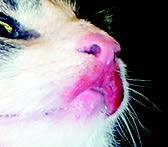Normally, one type of your cat’s white blood cells—called eosinophils—quietly do their job, healing lesions and preventing infections. But sometimes they overreact to a perceived threat, causing oozing masses, yellowish-pink ulcerations, or big tumor-like bumps. The lesions can be painful or itchy and, worse yet, can progress to cancer in rare cases.
These masses can appear almost anywhere on your cat. In some cases, particularly in young cats, the lesion may resolve on its own, but you must monitor the areas carefully to ensure the problem doesn’t worsen.
There are three distinct types of these eosinophilic lesions, but they all fall under the umbrella term “eosinophilic granuloma complex.”
“What ties them together is the most likely cause. They deserve to remain as a grouping because all three show the activity of eosinophils and have an apparent allergic condition as the triggering event,” says William H. Miller Jr., VMD, professor emeritus of medicine, Section of Dermatology at the Cornell University College of Veterinary Medicine.
The three types of lesions are:
Eosinophilic ulcers. These lesions have a well-defined border, are often red, but not painful or itchy. Usually found on the lip, they are also called rodent ulcers or indolent ulcers. Rarely, these ulcerated areas will morph into cancerous growths.
Eosinophilic plaque. This type is a raised, sharply defined area, usually on the cat’s abdomen or upper legs. It tends to be itchy, which makes the cat scratch at it, which can then lead to a bacterial skin infection, or pyoderma.
Eosinophilic granulomas. Presenting with a superficial, spherical mass of immune-system cells, these lesions are usually raised, clearly defined, and yellowish-pink. They can also be linear, and are usually found on the rear legs or in the mouth. Young cats are most likely to have eosinophilic granulomas.
Making matters worse, mast cells (another type of white blood cell) often also play a role in these lesions and will degranulate and cause intense licking and scratching. This, in turn, intensifies the need to lick, scratch, and chew. It’s a vicious cycle.
Diagnosis
You may notice your cat licking, chewing, or scratching vigorously and frequently at one spot. This is especially true of eosinophilic plaques and granulomas located on the body.
For ulcers on the lip or affected areas in the mouth, excessive drooling, possibly blood-tinged, might be the first clinical sign. Despite the appearance of the lip and oral ulcerated areas, most cats eat and drink normally. Some cats will have enlarged lymph nodes in the area, such as under the jaw.
A fine needle aspirate or biopsy are the definitive ways to diagnose these conditions, although some veterinarians are comfortable making a presumptive diagnosis based on appearance, location, examination, and history, often in an attempt to save the client money. “Just because it looks like an ulcer, plaque, or granuloma, doesn’t mean that it is one,” says Dr. Miller. “The lesion—especially if it’s big, chronic, or poorly responsive to conventional therapies—should have a cytology or biopsy done.”
Isolating the Cause
Eosinophilic skin conditions in cats are usually caused by hypersensitivity allergic reactions. If you can identify and remove the cause, your cat is much less likely to have a recurrence. Eosinophilic skin conditions may lead to hypersensitivity reactions to insect bites. Major offenders include fleas and mosquitoes.
Eosinophilic plaques are often due to adverse food reactions. Lesions start around the head and ears initially but can spread to the abdomen and are usually itchy. Adverse food reactions require feeding a restrictive hypoallergenic diet for at least six to eight weeks.
You can prepare a home-cooked hypoallergenic diet (in which certain ingredients are eliminated) to determine whether your cat is allergic to some component of her current diet (proteins are the most common culprit), but we advise consulting with a veterinary nutritionist to ensure it is balanced and complete if you choose to do this.
A better choice may be a commercial hypoallergenic diet that has a novel protein source, like kangaroo, or a commercial hydrolyzed diet. A hydrolyzed-diet food contains protein that has been chemically broken into highly digestible small pieces, reducing the risk of an immune reaction.
Airborne allergies, known as atopy, are best identified with intradermal skin testing. If atopy is diagnosed, your cat may require periodic injections to desensitize her immune system.
Treatment
Antihistamines or corticosteroids can control itchiness and help your cat become comfortable quickly. Treatment may be required for weeks or months to totally resolve the problem. Adding fatty acids to the diet—with veterinary approval—can help to minimize your kitty’s symptoms.
For cats who don’t handle steroids well, cyclosporine, an oral immunosuppressant drug, may work. Cyclosporine should only be used for indoor-only cats and cats on a cooked diet (commercial or home-prepared). The immunosuppression caused by this drug can predispose cats eating raw diets—which we do not recommend—to infections by pathogens that can be found in them.
Topical treatment and antibiotics may be necessary if the areas are infected. Use of an Elizabethan collar or other device to prevent her from biting or scratching while she heals is critical.
Follow through with treatment. The lesions look better on the surface before they are healed in the deep tissue. If treatment stops too soon, the odds are that it will come back and may become resistent to conventional medications.
Areas that resist treatment may progress to cancer, such as squamous cell carcinomas. For these cases, a biopsy is important, and if the sore is determined to be cancer, your veterinarian will discuss therapeutic options with you.




